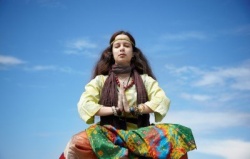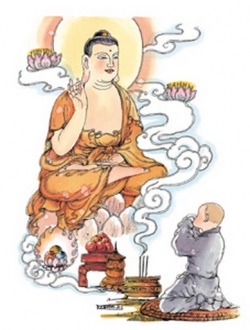Terma overview
Terma are “revelations” in approximately the same sense as in Western religions. However, there is a specifically Nyingma theory of how they come about. This theory is quite complex—and, as with all aspects of Tibetan Buddhism, for every rule there are many exceptions.
I will give only a simplified summary here. If you would like to learn more, I recommend highly Tulku Thondup Rinpoche’s Hidden Teachings of Tibet.
It is clear, short, interesting, and recognized as an authoritative work on the subject. In the Eighth Century, the Second Buddha Padmasambhava established Vajrayana Buddhism in Tibet. It reached its high point during his lifetime.
He recognized that it would repeatedly degenerate after his death. Buddhist teachings would be “adulterated like milk in the marketplace.” This is rather like the game of “telephone,” in which a message is whispered ear to ear: the meaning is gradually garbled by being passed along.
Accordingly, he—and other great practitioners of the time, such as Yeshe Tsogyal—concealed teachings to be discovered freshly in the future. These have been revealed as thousands of termas throughout the centuries that followed. Due to their value and concealment, “terma” is often translated “treasure.”
All termas say the same things. They never conflict in essential meaning. However, they present the same material in radically different styles. Particular presentations are useful in particular times and places, due to varying social and cultural conditions. So each terma has a particular historical role and must be revealed in the right circumstances.
Padmasambhava recognized that if he concealed his treasures in any ordinary way, they might be lost or degraded. So he hid them within the enlightened minds of his disciples.
These disciples are the tertons. They have been reborn repeatedly, and the enlightened nature of their minds retains the teachings. This enlightened nature is not fully accessible to their ordinary minds.
At appointed times, they receive a “key” which unlocks the terma hidden within.
In some cases, called earth terma, the key is a physical object that the terton physically discovers. Typically the object is a short scroll containing some key words of the terma. These words remind the terton of the whole terma.
In other cases, called mind terma, the key is non-physical. It might, for example, be a dream, vision, or a memory from a previous life.
It was commonly misunderstood in Tibet that the physical object was itself the terma, at least in the case of earth terma. Hidden Teachings of Tibet repeatedly emphasizes that this is never true. Terma are always hidden only in enlightened mind.
The discovery of terma is often accompanied by miracles, of bewildering variety.
After discovery, the terton practices the terma in secret for a period of several years. Eventually he or she teaches it to disciples, who practice and accomplish it, and propagate it to their own students.
Commonly, a terma is re-concealed and re-discovered. For example, one of the most widely-practiced termas currently is the Longchen Nyingthik. Originally this was transmitted by the Dharmakaya Buddha Kuntuzangpo to the Sambhogakaya Buddha Dorje Sempa, who transmitted it to Padmasambhava.
Padmasambhava concealed the Longchen Nyingthik in the mind of Longchenpa (1308-1363), who discovered it there. However, he did not make it public at that time. Instead, he appeared to Jigme Lingpa (1730-1798) in a series of three visions, and transmitted the terma to him then.
Similarly, the Aro gTer originated with the Dharmakaya Buddha Kuntuzangmo (consort of Kuntuzangpo), who transmitted it to the Sambhogakaya Buddha Seng-ge Dong-ma, who transmitted it to Yeshe Tsogyel (consort of Padmasambhava).
Yeshe Tsogyel revealed it in a pure vision to the terton Aro Lingma (1886-1923). [[Aro Lingma transmitted it to her son Aro Yeshe (1915-1951), who was reborn as Ngak’chang Rinpoche in 1952.

